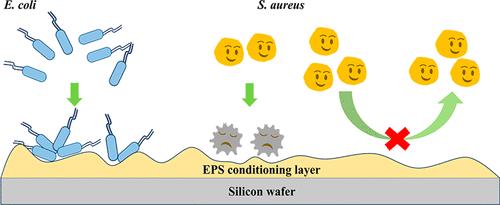地衣芽孢杆菌胞外聚合物质调节层介导细菌对受控生物膜形成的粘附行为
IF 3.9
2区 化学
Q2 CHEMISTRY, MULTIDISCIPLINARY
引用次数: 0
摘要
在水生环境中,调节层在调节浮游细菌的粘附和聚集方面起着至关重要的作用,最终促进生物膜的形成和生物污垢的不可逆发生。本研究报道了利用地衣芽孢杆菌分泌的胞外聚合物(EPS)构建简化调理层及其对细菌粘附行为的影响。结果表明,EPS调节层显著抑制金黄色葡萄球菌的粘附,同时促进大肠杆菌的聚集。EPS调理层表面呈平面形态,最高高度约为12.9 nm。调理层改变了衬底材料表面的物理化学性质,水接触角从61.23°变化到8.76°,zeta电位从- 1.0 mV变化到- 25.0 mV。尽管有这些变化,但发现EPS调节层对细菌粘附的总体影响很小。对细菌粘附和聚集行为的进一步研究表明,EPS的两种主要成分即多糖和杆菌肽影响细菌的粘附和聚集行为。杆菌肽在抑制金黄色葡萄球菌附着方面起主导作用,多糖促进大肠杆菌聚集。这些发现将为开发环境友好的有效生物措施以对抗世界范围内持续存在的生物污染提供鼓舞人心的见解。本文章由计算机程序翻译,如有差异,请以英文原文为准。

Bacillus licheniformis Extracellular Polymeric Substances Conditioning Layer Mediates the Bacterial Adhesion Behaviors toward Controlled Biofilm Formation
In aquatic environments, conditioning layers play a crucial role in modulating the adhesion and aggregation of planktonic bacteria, ultimately facilitating biofilm formation and the irreversible onset of biofouling. This study reports the construction of a simplified conditioning layer using extracellular polymeric substances (EPS) secreted by Bacillus licheniformis and its influence on the adherence behaviors of bacteria. The results reveal that the EPS conditioning layer remarkably inhibits the Staphylococcus aureus adherence yet promotes the aggregation of Escherichia coli. The surface of the EPS conditioning layer shows a flat morphology with the highest height of approximately 12.9 nm. The conditioning layer alters the physicochemical properties of the substrate materials on their surfaces, with water contact angles changing from 61.23° to 8.76° and the zeta potential changing from −1.0 to −25.0 mV. Despite these changes, the overall effect of the EPS conditioning layer on bacterial adhesion was found to be minimal. Further investigation on the bacterial adhesion and aggregation behaviors shows that two main components of EPS, namely, polysaccharides and bacitracin, affect the bacterial adhesion and aggregation behaviors. Bacitracin plays a predominant role in inhibiting the Staphylococcus aureus attachment, and the polysaccharides promote Escherichia coli aggregation. These findings would give inspiring insight into developing environmentally friendly efficient biological measures for combating the worldwide persisting biofouling.
求助全文
通过发布文献求助,成功后即可免费获取论文全文。
去求助
来源期刊

Langmuir
化学-材料科学:综合
CiteScore
6.50
自引率
10.30%
发文量
1464
审稿时长
2.1 months
期刊介绍:
Langmuir is an interdisciplinary journal publishing articles in the following subject categories:
Colloids: surfactants and self-assembly, dispersions, emulsions, foams
Interfaces: adsorption, reactions, films, forces
Biological Interfaces: biocolloids, biomolecular and biomimetic materials
Materials: nano- and mesostructured materials, polymers, gels, liquid crystals
Electrochemistry: interfacial charge transfer, charge transport, electrocatalysis, electrokinetic phenomena, bioelectrochemistry
Devices and Applications: sensors, fluidics, patterning, catalysis, photonic crystals
However, when high-impact, original work is submitted that does not fit within the above categories, decisions to accept or decline such papers will be based on one criteria: What Would Irving Do?
Langmuir ranks #2 in citations out of 136 journals in the category of Physical Chemistry with 113,157 total citations. The journal received an Impact Factor of 4.384*.
This journal is also indexed in the categories of Materials Science (ranked #1) and Multidisciplinary Chemistry (ranked #5).
 求助内容:
求助内容: 应助结果提醒方式:
应助结果提醒方式:


